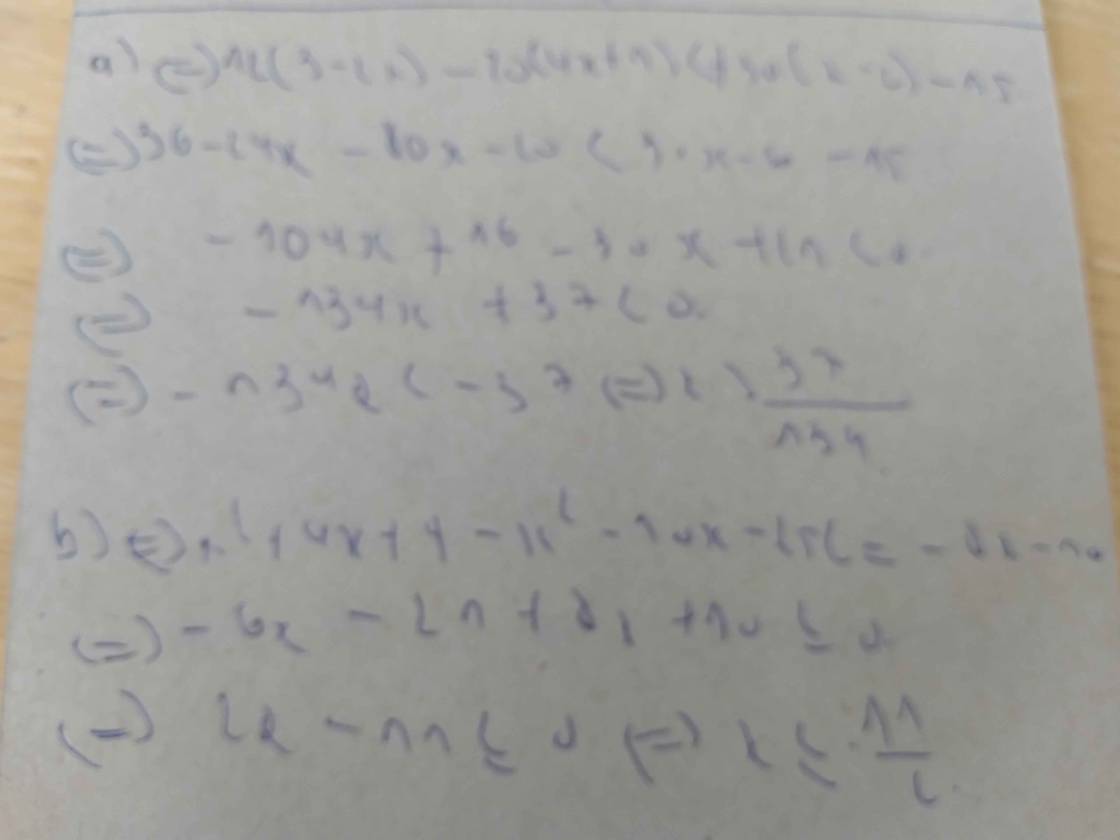Giải bpt: √x-1 + √3-x + 4x√2x ≥ x^3 +10
Hãy nhập câu hỏi của bạn vào đây, nếu là tài khoản VIP, bạn sẽ được ưu tiên trả lời.


`1-D`
Vì `7-2x=0` có dạng của ptr bậc nhất một ẩn `ax+b=0` trong đó `a=-2 \ne 0`
_________________________________________________
`2-C`
Vì `-x+1 < 0` có dạng bất ptr bậc nhất một ẩn `ax+b < 0` và `a=-1 \ne 0`
__________________________________________________
`3-A`
`4x-10 > x+2`
`<=>4x-x > 2+10`
`<=>3x > 12`
`<=>x > 4`
_________________________________________________
`4-C`
Vì tỉ số đồng dạng của `2` hai tam giác đồng dạng bằng tỉ số của `2` đường cao tương ứng của `2` tam giác đồng dạng đó

1.
- Với \(x\ge\frac{1}{2}\Rightarrow2x-1\le x+2\Rightarrow x\le3\Rightarrow\frac{1}{2}\le x\le3\)
- Với \(x< \frac{1}{2}\Rightarrow1-2x\le x+2\Rightarrow3x\ge-1\Rightarrow x\ge-\frac{1}{3}\)
Vậy nghiệm của BPT là \(-\frac{1}{3}\le x\le3\)
2.
Để pt có 2 nghiệm trái dấu
\(\Leftrightarrow ac< 0\Leftrightarrow\left(m+2\right)\left(2m-3\right)< 0\Rightarrow-2< m< \frac{3}{2}\)
3.
\(5x-1>\frac{2x}{5}+3\Leftrightarrow5x-\frac{2x}{5}>4\Leftrightarrow\frac{23}{5}x>4\Rightarrow x>\frac{20}{23}\)
4.
\(4x^2+4x+1-3x+9>4x^2+10\)
\(\Leftrightarrow x>0\)
5.
\(1< \frac{1}{1-x}\Leftrightarrow\frac{1}{1-x}-1>0\Leftrightarrow\frac{x}{1-x}>0\Rightarrow0< x< 1\)
6.
\(\frac{\left(x-5\right)^2\left(x-3\right)}{x+1}\le0\Rightarrow\left[{}\begin{matrix}x=5\\-1< x\le3\end{matrix}\right.\)

| 2-4x | = 4x-2
<=> \(\orbr{\begin{cases}\left|2-4x\right|=-2+4x=4x-2\\\left|2-4x\right|=2-4x=4x-2\end{cases}}\)
<=>\(\orbr{\begin{cases}-2+4x=4x-2\\2-4x=4x-2\end{cases}}\)
<=>\(\orbr{\begin{cases}-2+4x-4x+2=0\\2-4x-4x+2=0\end{cases}}\)
<=>\(\orbr{\begin{cases}0=0\\-8x+4=0\end{cases}}\)
<=> x=\(\frac{-4}{-8}=\frac{1}{2}\)
=> \(S=\left\{\frac{1}{2};\infty\right\}\)
2x-7> 3(x-1)
<=>2x-7>3x-3
<=>2x-3x>-3+7
<=>-x>4
<=>x<4
=>S={x/x<4}
1-2x<4(3x-2)
<=>1-2x<12x-8
<=>-2x-12x<-8-1
<=>-14x<-9
<=>x>\(\frac{9}{14}\)
=>S={\(\frac{9}{14}\)}
-3x+2|-4 -x|> 0
<=>\(\orbr{\begin{cases}-3x+2+4+x>0\\-3x+2-4x-x>0\end{cases}}\)
<=>\(\orbr{\begin{cases}-2x+6>0\\-8x+2>0\end{cases}}\)
<=>\(\orbr{\begin{cases}-2x>-6\\-8x>-2\end{cases}}\)
<=>\(\orbr{\begin{cases}x< 3\\x< \frac{1}{4}\end{cases}}\)
=>S={x/x<3;x/x<\(\frac{1}{4}\)}
4x-1|x-2|< 0
<=>\(\orbr{\begin{cases}4x-1-x+2< 0\\4x-1+x-2< 0\end{cases}}\)
<=>\(\orbr{\begin{cases}3x+1< 0\\3x-3< 0\end{cases}}\)
<=>\(\orbr{\begin{cases}3x< -1\\3x< 3\end{cases}}\)
<=>\(\orbr{\begin{cases}x< \frac{-1}{3}\\x< 1\end{cases}}\)
=>S={x/x<\(\frac{-1}{3}\);x/x<1}

a: =>17x-5x-15-2x-5=0
=>10x-20=0
=>x=2
b: =>\(\dfrac{3x-6-5x-10}{\left(x+2\right)\left(x-2\right)}=\dfrac{11x+23}{\left(x+2\right)\left(x-2\right)}\)
=>11x+23=-2x-16
=>13x=-39
=>x=-3(nhận)
c: =>5x+7>=3x-3
=>2x>=-10
=>x>=-5
d: =>5(3x-1)=-2(x+1)
=>15x-5=-2x-2
=>17x=3
=>x=3/17
e: =>4x^2-1-4x^2-3x-2=0
=>-3x-3=0
=>x=-1
g: =>7x-5-8x+2-7<0
=>-x-10<0
=>x+10>0
=>x>-10

a: =>17x-5x-15-2x-5=0
=>10x-20=0
=>x=2
b: =>\(\dfrac{3x-6-5x-10}{\left(x+2\right)\left(x-2\right)}=\dfrac{11x+23}{\left(x+2\right)\left(x-2\right)}\)
=>11x+23=-2x-16
=>13x=-39
=>x=-3(nhận)
c: =>5x+7>=3x-3
=>2x>=-10
=>x>=-5
d: =>5(3x-1)=-2(x+1)
=>15x-5=-2x-2
=>17x=3
=>x=3/17
e: =>4x^2-1-4x^2-3x-2=0
=>-3x-3=0
=>x=-1
g: =>7x-5-8x+2-7<0
=>-x-10<0
=>x+10>0
=>x>-10

Nhóm BPT : 2(2x^2+1)-√(2x^2+1)(x+1) -6(x+1)>0
Đk dưới căn có nghĩa x>=-1.
Với x=-1 là một nghiệm--> nhận x=-1
Với x>-1, chia 2 vế cho x+1>0, Bđt ko đổi chiều.
2.(2x^2+1)/(x+1) - √(2x^2+1)/(x+1) - 6 >0
Đặt t=√(2x^2+1)/(x+1) , t>0, ta được
2t^2-t-6>0 --> t>2 ....bài toán dễ dàng rồi!

\(a,\left(4x-1\right)\left(x^2+12\right)\left(-x+4\right)>0\)
\(\Leftrightarrow\left[{}\begin{matrix}4x-1>0\\x^2+12>0\left(LD\forall x\right)\\-x+4>0\end{matrix}\right.\)
\(\Leftrightarrow\left[{}\begin{matrix}4x>1\\-x>-4\end{matrix}\right.\)
\(\Leftrightarrow\left[{}\begin{matrix}x>\dfrac{1}{4}\\x< 4\end{matrix}\right.\)
Vậy \(S=\left\{x|\dfrac{1}{4}< x< 4\right\}\)
\(b,\left(2x-1\right)\left(5-2x\right)\left(1-x\right)< 0\)
\(\Leftrightarrow\left[{}\begin{matrix}2x-1< 0\\5-2x< 0\\1-x< 0\end{matrix}\right.\)
\(\Leftrightarrow\left[{}\begin{matrix}x< \dfrac{1}{2}\\x>\dfrac{5}{2}\\x< 1\end{matrix}\right.\)
Vậy \(S=\left\{x|1>x>\dfrac{5}{2}\right\}\)
